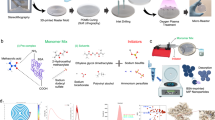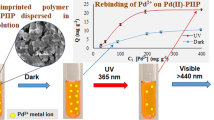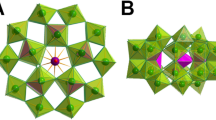Abstract
Molecularly imprinted polymers (MIPs) are synthetic materials, generally based on acrylic or methacrylic monomers, that are polymerized in the presence of a specific target molecule called the 'template' and capable of rebinding selectively to this target molecule. They have the potential to be low-cost and robust alternatives to biomolecules such as antibodies and receptors. When prepared by traditional synthetic methods (i.e., with free template in solution), their usefulness has been limited by high binding site heterogeneity, the presence of residual template and the fact that the production methods are complex and difficult to standardize. To overcome some of these limitations, we developed a method for the synthesis of MIP nanoparticles (nanoMIPs) using an innovative solid-phase approach, which relies on the covalent immobilization of the template molecules onto the surface of a solid support (glass beads). The obtained nanoMIPs are virtually free of template and demonstrate high affinity for the target molecule (e.g., melamine and trypsin in our published work). Because of an affinity separation step performed on the solid phase after polymerization, poor binders and unproductive polymer are removed, so the final product has more uniform binding characteristics. The overall protocol, starting from the immobilization of the template onto the solid phase and including the purification and characterization of the nanoparticles, takes up to 1 week.
This is a preview of subscription content, access via your institution
Access options
Subscribe to this journal
Receive 12 print issues and online access
$259.00 per year
only $21.58 per issue
Buy this article
- Purchase on Springer Link
- Instant access to full article PDF
Prices may be subject to local taxes which are calculated during checkout



Similar content being viewed by others
References
Shukla, A.A. & Thömmes, J. Recent advances in large-scale production of monoclonal antibodies and related proteins. Trends Biotechnol. 28, 253–261 (2010).
Ruigrok, V.J.B., Levisson, M., Eppink, M.H.M., Smidt, H. & Van Der Oost, J. Alternative affinity tools: more attractive than antibodies? Biochem. J. 436, 1–13 (2011).
Mueller, M., Loh, M.Q.T., Tee, D.H.Y., Yang, Y. & Jungbauer, A. Liquid formulations for long-term storage of monoclonal IgGs. Appl. Biochem. Biotechnol. 169, 1431–1448 (2013).
Mueller, M. et al. Liquid formulations for stabilizing IgMs during physical stress and long-term storage. Pharm. Res. 30, 735–750 (2013).
Szenczi, A., Kardos, J., Medgyesi, G.A. & Závodszky, P. The effect of solvent environment on the conformation and stability of human polyclonal IgG in solution. Biologicals 34, 5–14 (2006).
Ahrer, K., Buchacher, A., Iberer, G. & Jungbauer, A. Thermodynamic stability and formation of aggregates of human immunoglobulin G characterised by differential scanning calorimetry and dynamic light scattering. J. Biochem. Biophys. Methods 66, 73–86 (2006).
Murphy, B.M. et al. Protein instability following transport or storage on dry ice. Nat. Methods 10, 278–279 (2013).
Hoshino, Y. et al. Recognition, neutralization, and clearance of target peptides in the bloodstream of living mice by molecularly imprinted polymer nanoparticles: a plastic antibody. J. Am. Chem. Soc. 132, 6644–6645 (2010).
Yoshimatsu, K., Koide, H., Hoshino, Y. & Shea, K.J. Preparation of abiotic polymer nanoparticles for sequestration and neutralization of a target peptide toxin. Nat. Protoc. 10, 595–604 (2015).
Ma, Y., Pan, G., Zhang, Y., Guo, X. & Zhang, H. Narrowly dispersed hydrophilic molecularly imprinted polymer nanoparticles for efficient molecular recognition in real aqueous samples including river water, milk, and bovine serum. Angew. Chem. Int. Ed. 52, 1511–1514 (2013).
Ambrosini, S., Beyazit, S., Haupt, K. & Tse Sum Bui, B. Solid-phase synthesis of molecularly imprinted nanoparticles for protein recognition. Chem. Commun. 49, 6746–6748 (2013).
Poma, A. et al. Solid-phase synthesis of molecularly imprinted polymer nanoparticles with a reusable template–“plastic antibodies”. Adv. Funct. Mater. 23, 2821–2827 (2013).
Chianella, I. et al. Direct replacement of antibodies with molecularly imprinted polymer nanoparticles in ELISA—development of a novel assay for vancomycin. Anal. Chem. 85, 8462–8468 (2013).
Korposh, S. et al. Selective vancomycin detection using optical fibre long period gratings functionalised with molecularly imprinted polymer nanoparticles. Analyst 139, 2229–2236 (2014).
Poma, A., Guerreiro, A., Caygill, S., Moczko, E. & Piletsky, S. Automatic reactor for solid-phase synthesis of molecularly imprinted polymeric nanoparticles (MIP NPs) in water. RSC Adv. 4, 4203–4206 (2014).
Basozabal, I., Guerreiro, A., Gomez-Caballero, A., Aranzazu Goicolea, M. & Barrio, R.J. Direct potentiometric quantification of histamine using solid-phase imprinted nanoparticles as recognition elements. Biosens. Bioelectron. 58, 138–144 (2014).
Moczko, E. et al. Surface-modified multifunctional MIP nanoparticles. Nanoscale 5, 3733–3741 (2013).
Hermanson, G.T. Bioconjugate Techniques 3rd edn. (Academic Press, 2013).
Sheng, H. & Ye, B.C. Different strategies of covalent attachment of oligonucleotide probe onto glass beads and the hybridization properties. Appl. Biochem. Biotechnol. 152, 54–65 (2009).
Chen, Y.X., Triola, G. & Waldmann, H. Bioorthogonal chemistry for site-specific labeling and surface immobilization of proteins. Acc. Chem. Res. 44, 762–773 (2011).
Rao, S.V., Anderson, K.W. & Bachas, L.G. Oriented immobilization of proteins. Mikrochim. Acta 128, 127–143 (1998).
Marchyk, N., Maximilien, J., Beyazit, S., Haupt, K. & Sum Bui, B.T. One-pot synthesis of iniferter-bound polystyrene core nanoparticles for the controlled grafting of multilayer shells. Nanoscale 6, 2872–2878 (2014).
Karim, K. et al. How to find effective functional monomers for effective molecularly imprinted polymers? Adv. Drug Deliv. Rev. 57, 1795–1808 (2005).
Chianella, I. et al. Rational design of a polymer specific for microcystin-LR using a computational approach. Anal. Chem. 74, 1288–1293 (2002).
Khan, M.S., Wate, P.S. & Krupadam, R.J. Combinatorial screening of polymer precursors for preparation of benzo[α] pyrene imprinted polymer: an ab initio computational approach. J. Mol. Model. 18, 1969–1981 (2012).
Altintas, Z., Guerreiro, A., Piletsky, S.A. & Tothill, I.E. NanoMIP-based optical sensor for pharmaceuticals monitoring. Sens. Actuat. B Chem. 213, 305–313 (2015).
Abdin, M.J., Altintas, Z. & Tothill, I.E. In silico–designed nanoMIP-based optical sensor for endotoxins monitoring. Biosens. Bioelectron. 67, 177–183 (2015).
Berghaus, M., Mohammadi, R. & Sellergren, B. Productive encounter: molecularly imprinted nanoparticles prepared using magnetic templates. Chem. Commun. 50, 8993–8996 (2014).
Guerreiro, A. et al. Influence of surface-imprinted nanoparticles on trypsin activity. Adv. Healthc. Mater. 3, 1426–1429 (2014).
Mistry, J., Guerreiro, A., Moczko, E., Piletska, E., Karim, K. & Piletsky, S. Analysis of cooperative interactions in molecularly imprinted polymer nanoparticles. Mol. Imprint. 3 doi:10.1515/molim-2015-0003 (2016).
Acknowledgements
This research was supported by the Wellcome Trust with a Translation Award and by the Research Executive Agency (REA) of the European Union under grant agreement number PITN-GA-2010-264772 (ITN CHEBANA). A.P. is a recipient of the National Centre for the Replacement, Refinement & Reduction of Animals in Research (NC3Rs) David Sainsbury Fellowship.
Author information
Authors and Affiliations
Contributions
F.C., A.P., A.G. and S.P. developed the protocols. F.C., A.G. and A.P. contributed the data and wrote the paper. All authors have discussed the results and approved the final version of the manuscript.
Corresponding author
Ethics declarations
Competing interests
The authors declare no competing financial interests.
Rights and permissions
About this article
Cite this article
Canfarotta, F., Poma, A., Guerreiro, A. et al. Solid-phase synthesis of molecularly imprinted nanoparticles. Nat Protoc 11, 443–455 (2016). https://doi.org/10.1038/nprot.2016.030
Published:
Issue Date:
DOI: https://doi.org/10.1038/nprot.2016.030
This article is cited by
-
Electrochemical and thermal detection of allergenic substance lysozyme with molecularly imprinted nanoparticles
Analytical and Bioanalytical Chemistry (2023)
-
Optimisation of electrochemical sensors based on molecularly imprinted polymers: from OFAT to machine learning
Analytical and Bioanalytical Chemistry (2023)
-
A molecularly imprinted polymer nanoparticle-based surface plasmon resonance sensor platform for antibiotic detection in river water and milk
Analytical and Bioanalytical Chemistry (2022)
-
Biochemistry strategies for label-free optical sensor biofunctionalization: advances towards real applicability
Analytical and Bioanalytical Chemistry (2022)
-
BioMIPs: molecularly imprinted silk fibroin nanoparticles to recognize the iron regulating hormone hepcidin
Microchimica Acta (2022)
Comments
By submitting a comment you agree to abide by our Terms and Community Guidelines. If you find something abusive or that does not comply with our terms or guidelines please flag it as inappropriate.



